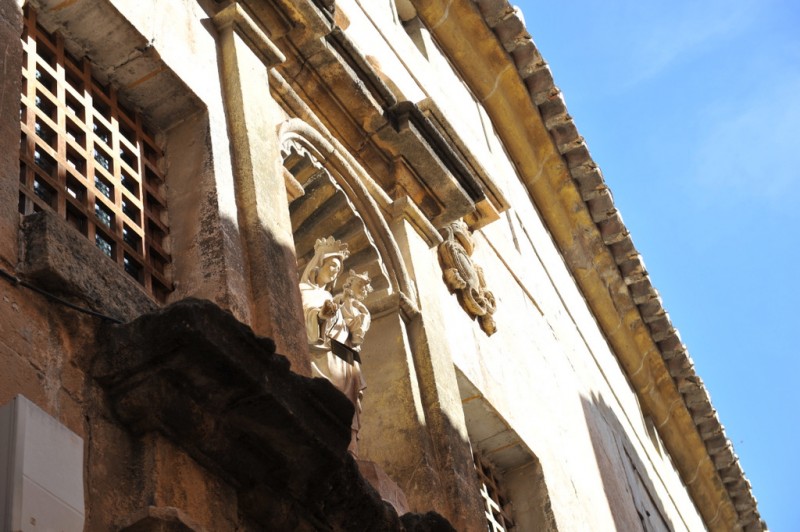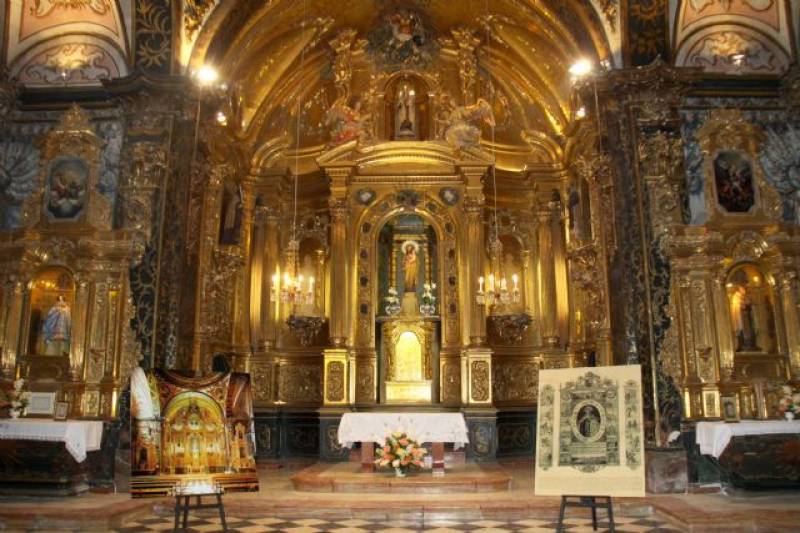Contact Caravaca Tourist Office +34 968 70 24 24
or send an Email
Click Here



















Contact Caravaca Tourist Office +34 968 70 24 24
or send an Email
Click Here
This site uses cookies. By continuing to browse the site, you are agreeing to our use of cookies. Read More (privacy and cookie policy)


 The baroque 16th-century convent church of San José stands on the Calle Mayor in the centre of Caravaca de la Cruz, and was founded in 1576 during the reforming fervour of the Carmelite Order which owed much to Santa Teresa de Jesús. However, Teresa was unable to attend the founding ceremony in person due to unexpected problems which cropped up in Sevilla as she was preparing to make the journey from Beas de Segura.
The baroque 16th-century convent church of San José stands on the Calle Mayor in the centre of Caravaca de la Cruz, and was founded in 1576 during the reforming fervour of the Carmelite Order which owed much to Santa Teresa de Jesús. However, Teresa was unable to attend the founding ceremony in person due to unexpected problems which cropped up in Sevilla as she was preparing to make the journey from Beas de Segura.
The founding of the convent and church
Nowadays the location might be central, but during the 16th century it was outside the city walls of Caravaca, and the new religious establishment occupied an area on which there were previously a row of houses and a small church dedicated to the Padre de Jesús on the road to Andalucía.
The history of the convent of San José de las Madres Carmelitas Descalzas begins in March 1575, when four young women from noble families attended a Mass conducted in the Iglesia de la Compañía de Jesús by a Jesuit priest and vowed not to return to their homes until Teresa de Ávila decided to found a convent belonging to the reformed Carmelite order in the city. In effect they staged a “sit-in” in the house of one Catalina de Otálora, who offered them shelter and support and helped them to communicate their wish to Teresa in the convent of San José de Ávila.

The saintly reformer acceded to the petition and planned a journey to Caravaca, but this never materialized and instead she sent a formal letter outlining her instructions to the Prioress of Caravaca, Ana de San Alberto: this letter, dated 24th November 1575, is still kept in the local historical Archive. Following this the bulk of the preparatory work was carried out by Catalina de Otálora and Rodrigo de Moya, the father of one of the four women whose determination led to the founding of the Order in Caravaca.
This was no easy task, and one initial problem was that the government of King Felipe II specified in its permission for the founding that the convent should come under the control of the Order of Santiago. Teresa de Ávila was not satisfied with this, and repeated her demand for it to be controlled directly by the Order of the Virgen del Carmen, a request which was granted prior to the official founding ceremony on 1st January 1576.
Construction then began, although slowly, with the acquisition of neighbouring houses and the church dedicated to San José in 1589.

The result is a three-floor building on Calle Mayor, although the lower floor is below ground level on the street side and opens out only onto the garden behind, containing 26 rooms to house members of the Order distributed around a central patio and the convent church. This church was originally built in the 17th century but additional decorative elements were added in the 18th.
This church backs on to the rest of the convent complex and the two areas are joined via the choir. The rich decoration is the most striking feature, but the building was sold by the Carmelite Order in 2004 and the religious works of art were removed and taken to a new location in Mazarrón. However, the magnificent altar screens can still be seen, as can the organ and an unusual confessional decorated with small reflective panels.
Location: Calle Mayor, 35 (click for map)
Santa Teresa de Ávila
Santa Teresa de Ávila, or Santa Teresa de Jesús, was born on 28th March 1515 in Ávila, where a church dedicated to her now stands at her birthplace.
Her life’s work was devoted to the foundation of convents dedicated to San José, the first of them in her home city and then others in Medina, Malagón, Valladolid, Toledo, Pastrana, Salamanca, Alba, Segovia, Beas, Sevilla, Villanueva del Jarama, Palencia, Soria, Caravaca de la Cruz and Burgos. In all of them she reinstated the strict purity and sobriety of the rules laid down by San Alberto.
It is said that she died physically exhausted in Alba de Tormes in 1582, when she was 67 years old. She was canonized by Pope Gregory XV in 1622.
Opening times in 2024
During the Holy Jubilee year of 2024 the church of San José is open as follows: weekdays 10.00 to 14.00 and 16.30 to 19.30, Saturdays 10.30 to 14.00 and 16.30 to 19.30, Sundays 10.30 to 14.00.
The monthly guided tours are scheduled for the 15th of every month at 12.00 midday with registration cost of 5 euros per person. Bookings can be made at any of the municipal museums or be email to reservas@caravacadelacruz.es.
Further information about Caravaca is available from the tourist office (Plaza de España, 7, telephone 968 702424, email turismo@caravacadelacruz.es).
Or for more local information, including the Holy Jubilee Year as well as local news and what’s on, go to the home page of Caravaca Today.




Hello, and thank you for choosing CamposolToday.com to publicise your organisation’s info or event.
Camposol Today is a website set up by Murcia Today specifically for residents of the urbanisation in Southwest Murcia, providing news and information on what’s happening in the local area, which is the largest English-speaking expat area in the Region of Murcia.
When submitting text to be included on Camposol Today, please abide by the following guidelines so we can upload your article as swiftly as possible:
Send an email to editor@camposoltoday.com or contact@murciatoday.com
Attach the information in a Word Document or Google Doc
Include all relevant points, including:
Who is the organisation running the event?
Where is it happening?
When?
How much does it cost?
Is it necessary to book beforehand, or can people just show up on the day?
…but try not to exceed 300 words
Also attach a photo to illustrate your article, no more than 100kb

